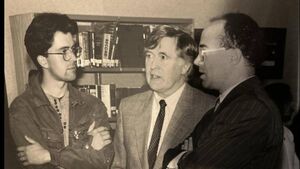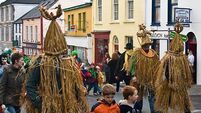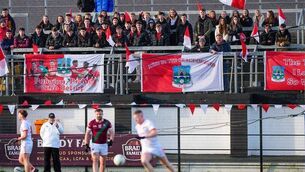Athy volunteers laid groundwork for Shackleton Experience

Seamus Taaffe, Frank Taaffe and Liam Kenny at Athy Museum Society lecture in the Town Hall circa 1989
ON FRIDAY, 10 October at 11am, the Shackleton Museum will officially be opened by the Minister for Rural Community Development and the Gaeltacht Dara Calleary TD whose Department provided substantial funding for the redevelopment of the Town Hall.
It was in February 1983 that a public meeting, called for the courthouse, resulted in the setting up of Athy’s Museum Society.
The vast majority of those who attended that meeting and who paid the membership fee of ten pounds each are no longer with us.
It is important that the names of those original members of Athy Museum Society should be recorded and their contribution to the development of our understanding of Athy’s cultural and heritage past be acknowledged.
Those persons who came together over forty years ago were Pat Mulhall, Ger Moriarty, Dick Norris, Patsy O’Neill, Mick Rowan, Megan Maguire, Frank English, Pat Doyle, Noreen Ryan, Denis Smyth, Joe May, Thomas Prendergast, Donal Murphy, Michael Wall and Jack Lawler. Following a lecture in the Leinster Arms Hotel on 21 March 1983, further locals joined the Society including Tommy Keegan, Ken Sale, Dermot Murphy, John Mahon and his family, Claire Behan, Jens Priesler and his wife May.
The above are the people who gave their support when it was most needed, for without their support there would have been no heritage town status, no museum in the various venues used over the years and certainly no Shackleton Museum.
The contribution of Kildare County Council officials cannot be overlooked. It was Gerry Ward, Kildare County Manager, who in response to my letter replied on 20 July 1983 confirming that he was prepared to recommend to the Council that a room in the Town Hall be made available to the Museum Society.
He proved true to his word for some years later the Town Hall caretaker’s accommodation became free and the Society’s Museum, which up to then was located in a vacant classroom of Mount St Mary’s, transferred to the Town Hall building.
The kindness of the Sisters of Mercy in providing the Mount St Mary’s room free of charge must be acknowledged.
The museum society’s involvement in obtaining ‘Heritage Town’ status for Athy is well known, as was the use by the Society and Kildare County Council of the monies then awarded by the department in the redevelopment of the ground floor of the Town Hall.
It was at this stage of the museum’s development that the Museum Society, a voluntary organisation, gave way to a company limited by guarantee, Athy Heritage Company Limited. The directors were still volunteers. It was those volunteers, who in conjunction with the Shackleton Autumn School, embarked on the next stage of the museum’s development as the Shackleton Museum.
Going through my papers, I was interested to find reports from Patrick Shaffrey, architect and town planner, and another report from Paul Kane, consulting engineer regarding Athy’s Town Hall.
The Shaffrey Report dated September 1982 showed his concern that the building ‘now presents a rather sorry appearance’ and that ‘the demolition of such a fine building would be a sad and irreplaceable loss to the architectural heritage of Athy and would change radically the appearance of the centre of the town.’
The Kane structural report sought by the local branch of An Taisce noted that while the building had deteriorated while occupied by the fire brigade and Athy Urban District Council, it was generally structurally sound with minor problems, all related to the maintenance of the roof.
It is quite possible that use of the Town Hall as a heritage centre and later on as a Museum saved the Town Hall because Athy Urban District Council had previously discussed its demolition to create more parking spaces in the town centre.
Throughout this article, I have consistently referred to the Shackleton Museum, although Kildare County Council now reference the ‘Shackleton Experience’. To me it will always be the Shackleton Museum.
Despite this, I must acknowledge the excellent work done by several heads of Kildare County Council in relation to the museum. First amongst those officials was the late Gerry Ward, county manager, who believed in the Museums Society’s drive for a museum in Athy and who helped whenever he could.
Peter Carey, whom I invited to open the Shackleton Autumn School soon after he took up the position of chief executive of Kildare County Council, was extremely helpful and facilitated the financing and erection of the Shackleton statue, the purchase of the ship cabin in which Shackleton died, and several other Shackleton artefacts which now form part of the museum’s display material.
The current chief executive, Sonya Kavanagh, and her senior staff took the opportunity to take over responsibility of financing and running the Shackleton Museum from the volunteers who had held administrative control for over forty years.
The journey which started in February 1983 continues today.
Sadly, many of the men and women I have mentioned earlier who shared a dream did not live to see this day.






